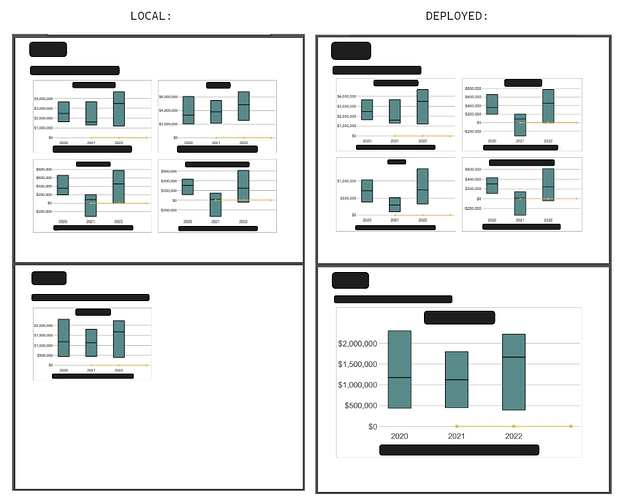Hi! I want to share a strange behavior I experience with the contents of a PDF generated in a Shiny app.
In the following image you can see what the same code outputs locally vs deployed (I have manually added black rectangles to hide sensitive information):
Details
I'm using gridExtra package (v 2.3) to display up to four charts created with ggplot2 (v 3.5.1) with some additional "blank space" between them. The blank space is generated with "empty charts". This is the code I'm using to add the charts to the PDF:
# Proxy around chart spacing
blank_space <- ggplot2::ggplot() +
ggplot2::theme(panel.background = ggplot2::element_rect(fill = "white"))
output_chart <- gridExtra::grid.arrange(
gridExtra::arrangeGrob(
charts[["p1"]], blank_space, charts[["p2"]],
blank_space, blank_space, blank_space,
charts[["p3"]], blank_space, charts[["p0"]],
nrow = 3, ncol = 3,
# height/width is close to fig.asp option defined in report.Rmd
widths = c(20, 1, 20), heights = c(12, 1, 12)
)
)
# print() was showing undesired string below charts
grid::grid.draw(output_chart)
In pages where there are 2 or more charts, the behavior is the same both locally and in the deployed version.
For some reason, on the deployed version, when there is a single chart to be displayed, the chart occupies the full page, which is not expected.
What is even more strange is that adding "empty chart placeholders" with non-white borders displays the charts correctly. I attach some code below that generates these placeholder charts:
chart_placeholder <- ggplot2::ggplot() +
ggplot2::geom_abline(slope = 1, intercept = 0, color = "grey") +
ggplot2::theme(panel.background = ggplot2::element_rect(fill = "white", color = "grey"))
charts <- NULL
charts$p0 <- chart_placeholder
charts$p1 <- chart_placeholder
charts$p2 <- chart_placeholder
charts$p3 <- chart_placeholder
If the border color is "white", the chart occupies the full page in the deployed version.
Any help is appreciated! This is my sessionInfo:
R version 4.4.0 (2024-04-24 ucrt)
Platform: x86_64-w64-mingw32/x64
Running under: Windows 11 x64 (build 22631)
Matrix products: default
locale:
[1] LC_COLLATE=English_United States.utf8 LC_CTYPE=English_United States.utf8 LC_MONETARY=English_United States.utf8
[4] LC_NUMERIC=C LC_TIME=English_United States.utf8
time zone: America/Buenos_Aires
tzcode source: internal
attached base packages:
[1] stats graphics grDevices datasets utils methods base
other attached packages:
[1] shiny_1.8.1.1 benchmark_0.0.1
loaded via a namespace (and not attached):
[1] gtable_0.3.5 xfun_0.44 bslib_0.7.0 ggplot2_3.5.1 shinyjs_2.1.0
[6] vctrs_0.6.5 tools_4.4.0 generics_0.1.3 curl_5.2.1 tibble_3.2.1
[11] fansi_1.0.6 AzureCosmosR_1.0.0 pkgconfig_2.0.3 desc_1.4.3 shinyalert_3.1.0
[16] lifecycle_1.0.4 farver_2.1.2 compiler_4.4.0 stringr_1.5.1 tinytex_0.51
[21] munsell_0.5.1 fontawesome_0.5.2 ggstance_0.3.7 golem_0.4.1 waiter_0.2.5
[26] httpuv_1.6.15 shinyWidgets_0.8.6 htmltools_0.5.8.1 sass_0.4.9 yaml_2.3.8
[31] AzureAuth_1.3.3 AzureRMR_2.4.4 later_1.3.2 pillar_1.9.0 jquerylib_0.1.4
[36] tidyr_1.3.1 rsconnect_1.3.0 openssl_2.2.0 cachem_1.1.0 mime_0.12
[41] tidyselect_1.2.1 digest_0.6.35 stringi_1.8.4 dplyr_1.1.4 purrr_1.0.2
[46] labeling_0.4.3 rprojroot_2.0.4 fastmap_1.2.0 grid_4.4.0 colorspace_2.1-0
[51] cli_3.6.2 magrittr_2.0.3 bsicons_0.1.2 pkgbuild_1.4.4 utf8_1.2.4
[56] withr_3.0.0 scales_1.3.0 promises_1.3.0 rappdirs_0.3.3 httr_1.4.7
[61] roxygen2_7.3.1 rmarkdown_2.27 config_0.3.2 gridExtra_2.3 askpass_1.2.0
[66] AzureGraph_1.3.4 memoise_2.0.1 kableExtra_1.4.0 evaluate_0.23 knitr_1.47
[71] shinycssloaders_1.0.0 viridisLite_0.4.2 rlang_1.1.3 Rcpp_1.0.12 xtable_1.8-4
[76] glue_1.7.0 xml2_1.3.6 renv_1.0.3 pkgload_1.3.4 attempt_0.3.1
[81] svglite_2.1.3 rstudioapi_0.16.0 jsonlite_1.8.8 R6_2.5.1 systemfonts_1.1.0
[86] fs_1.6.4

